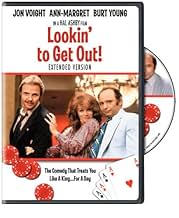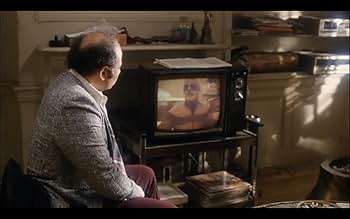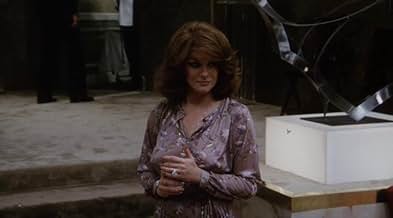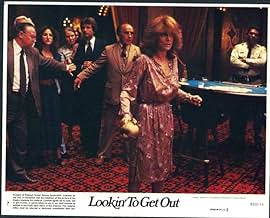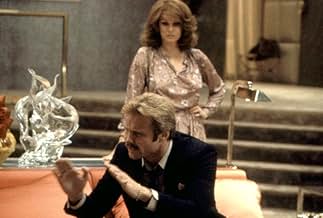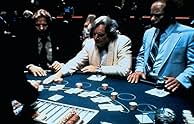Agrega una trama en tu idiomaAlex has had a good day at the track, a bad night at the poker game and hell have a worse time if the guys he owes catch up with him. So Alex and go-along pal Jerry split for Las Vegas...Alex has had a good day at the track, a bad night at the poker game and hell have a worse time if the guys he owes catch up with him. So Alex and go-along pal Jerry split for Las Vegas...Alex has had a good day at the track, a bad night at the poker game and hell have a worse time if the guys he owes catch up with him. So Alex and go-along pal Jerry split for Las Vegas...
- Dirección
- Guionistas
- Elenco
Jude Farese
- Harry
- (as Jude Ferrese)
Larry Flash Jenkins
- Parking Attendant - Brings Up the Car
- (as Larry 'Flash' Jenkins)
Hank Robinson
- Poker Player
- (as Henry Robinson)
Sig Frohlich
- Poker Game Dealer
- (as Sigmond Frohlick)
- Dirección
- Guionistas
- Todo el elenco y el equipo
- Producción, taquilla y más en IMDbPro
Opiniones destacadas
Seven stars. A weak seven, but good enough to round up. Hal Ashby
had, possibly, the best six-consecutive film run in history from Harold and
Maude through Being There. This film clearly does not match that amazing run,
but it's still a lot of fun. Jon Voigt, an actor I've been a fan of for 50
years now, turns in an excellent performance as a more-wily-than-smart gambler
trying to square a big debt. Ann-Margret does fine as his ex, who figures out
he's running a con at the Vegas spot where she now works. But for my money,
the show is stolen by Burt Young. He did tons of movie and TV work, and was a
tremendous actor. But he was too dumpy looking to be a star. In a career of
character parts, this was one of his biggest shots, and he just nailed the loyal, not
as dumb as everyone thinks, sidekick.
Ashby's career as a director was pretty short, and he really faded from prominence in the last few years of his life. But he was still making quirky, intelligent, entertaining films. The film from his big six that is closest to this is probably The Last Detail. If you liked that one, take a look a this. 20 September 2022.
Ashby's career as a director was pretty short, and he really faded from prominence in the last few years of his life. But he was still making quirky, intelligent, entertaining films. The film from his big six that is closest to this is probably The Last Detail. If you liked that one, take a look a this. 20 September 2022.
I thought this film was excellent! I saw the extended version on DVD so uncertain what the clipped version looks like.
Jon Voight is superlative as the annoying wise guy gambler. Burt Young doesn't appear to be acting as the NYC street wise buddy - he is that good or at least well cast. Ann-Margret nails it as the old girl-friend who can't quite get Voight's character Alex out of her system. She is smoldering every time she is on screen and she really keeps the viewer enthralled with all the male actors vying for attention. Her extended kiss as Patti Warner with Alex will jolt male and female viewers alike with its tenderness and anticipation!
Should be required viewing for anyone with, or knows someone with a gambling addiction!
Really combines some of the best elements of Ocean's 11, The Sting and Don Quixote. Don't miss the last 15 minutes to see who is conning who.
The scene with real life father Jon Voight and daughter Angelina Jolie is not to be missed as it came off surreal to me. Watch and see what I mean.
Jon Voight is superlative as the annoying wise guy gambler. Burt Young doesn't appear to be acting as the NYC street wise buddy - he is that good or at least well cast. Ann-Margret nails it as the old girl-friend who can't quite get Voight's character Alex out of her system. She is smoldering every time she is on screen and she really keeps the viewer enthralled with all the male actors vying for attention. Her extended kiss as Patti Warner with Alex will jolt male and female viewers alike with its tenderness and anticipation!
Should be required viewing for anyone with, or knows someone with a gambling addiction!
Really combines some of the best elements of Ocean's 11, The Sting and Don Quixote. Don't miss the last 15 minutes to see who is conning who.
The scene with real life father Jon Voight and daughter Angelina Jolie is not to be missed as it came off surreal to me. Watch and see what I mean.
ctitus924 states in the previous review that you can see the MGM Grand in Cher's Believe DVD - that is not true - the MGM Grand in this film was involved in a major fatal fire in 1980 and was then sold - it is now Bally's hotel and casino in Vegas. The MGM Grand in Cher's video is newer - it was built later and is farther down the strip. As for the movie- I am watching it now as I type and while it is great to see old Vegas locations, so far I am finding it a little slow moving...but interesting to see Vegas in the late 70's when this was filmed. There are some great clips of various Vegas acts and the cast of recognizable actors in the film is impressive.
Before I get into my critique of "Lookin' To Get Out", I feel I should mention that I saw the original theatrical cut of the movie via finding an old VHS release of the movie. Supposedly, the DVD release of this movie runs 15 extra minutes and supposedly improves the movie. That may be the case, but from what I saw, I can't see any extra footage making a big improvement of the mess that I saw. True, the DVD cut may explain a number of unanswered questions the original cut had, like why one character has bandages over one of his eyes. But the movie would still have a slow and plot less feel - it frequently feels that the actors are making it up as they go along. And while I think Voight and Young are talented actors, they give extremely annoying performances. The only thing that survives intact is the performance by Bert Remsen as the professional gambler - he's colorful, and commands the screen in his scenes. But even he can't save the movie enough to make it worth watching.
Novices will dismiss this gorgeous movie as drek, pointing out that the only "good" thing about it was Angelina Jolie when she was 4 years old. First of all, anyone who is an Angelina "fan" has problems of their own, and are in no position to criticize anything, much less art, like this great movie.
Put simply, this is the best movie about friendship I have ever seen. The writing is spectacular, as Jon Voight really understood how to express to the audience the love these two guys had as friends. The subtleties in the acting are wonderful to watch, like when Alex (Voight's character) yells at Jerry (Burt Young's character) for losing all his money at the race track. He screams at him, but then remembers that his friend is his friend, faults and all, and walks up to Jerry, pats him on the back and says, "Come on, let's go get some breakfast." The physicality of the pat on the back was a lovely touch, just like the Italian brothers fighting on the beach in "Big Night". The brothers "fought" with love, not really hitting each other. The two guys in "Looking to get Out" accept each other with all their faults, like no other two characters I've ever seen in film or TV. One scene has Jerry telling a p***ed off casino owner that his friend (Alex) doesn't understand how impossible he (Alex)is, but that he (Jerry) does, and that's why he's his friend. To which a very indignant Alex (Voight) says to the casino owner, "How 'bout that?", and the two of them walk out together, having lost all their money, up to thier necks in deep ca-ca, but still having each other. Yet another wonderful moment in the film is when Alex has gotten them into more trouble, and Jerry says this about Alex... "You know, he's a great guy to have in a jam. Problem is that he's the one who got you into the jam in the first place." Great writing, wonderfully acted by all the cast.
This film is rich. Rich with one-liners, rich with wonderful characters all the way around, and rich in humanity. This is a gorgeous film, and if you're ever lucky enough to see it, grab it, and never let it go. Of all of Jon Voight's movies, this would be the one I'd like to talk with him about. What a gem! "Coming Home", "Midnight Cowboy", "Table For Five", yes, they're good, but "Looking To Get Out" stands alone. Of course you have to understand film and writing to appreciate it. You can't just be in the Angelina Jolie fan club.
Put simply, this is the best movie about friendship I have ever seen. The writing is spectacular, as Jon Voight really understood how to express to the audience the love these two guys had as friends. The subtleties in the acting are wonderful to watch, like when Alex (Voight's character) yells at Jerry (Burt Young's character) for losing all his money at the race track. He screams at him, but then remembers that his friend is his friend, faults and all, and walks up to Jerry, pats him on the back and says, "Come on, let's go get some breakfast." The physicality of the pat on the back was a lovely touch, just like the Italian brothers fighting on the beach in "Big Night". The brothers "fought" with love, not really hitting each other. The two guys in "Looking to get Out" accept each other with all their faults, like no other two characters I've ever seen in film or TV. One scene has Jerry telling a p***ed off casino owner that his friend (Alex) doesn't understand how impossible he (Alex)is, but that he (Jerry) does, and that's why he's his friend. To which a very indignant Alex (Voight) says to the casino owner, "How 'bout that?", and the two of them walk out together, having lost all their money, up to thier necks in deep ca-ca, but still having each other. Yet another wonderful moment in the film is when Alex has gotten them into more trouble, and Jerry says this about Alex... "You know, he's a great guy to have in a jam. Problem is that he's the one who got you into the jam in the first place." Great writing, wonderfully acted by all the cast.
This film is rich. Rich with one-liners, rich with wonderful characters all the way around, and rich in humanity. This is a gorgeous film, and if you're ever lucky enough to see it, grab it, and never let it go. Of all of Jon Voight's movies, this would be the one I'd like to talk with him about. What a gem! "Coming Home", "Midnight Cowboy", "Table For Five", yes, they're good, but "Looking To Get Out" stands alone. Of course you have to understand film and writing to appreciate it. You can't just be in the Angelina Jolie fan club.
¿Sabías que…?
- TriviaDebut theatrical feature film of Angelina Jolie, who appeared in the movie at age five.
- Versiones alternativasAn extended version of the film was released on DVD on June 30, 2009. It runs 15 minutes longer than the theatrical cut, at 120 minutes.
- ConexionesFeatured in At the Movies: Dueling Critics (1983)
- Bandas sonorasLookin' to Get Out
Music & Lyrics by Johnny Mandel, George Doering & Jo Ellen Doering
Sung by Tommie Lee Bradley, David Palmer, Paul Delf, Mark Burger
Selecciones populares
Inicia sesión para calificar y agrega a la lista de videos para obtener recomendaciones personalizadas
- How long is Lookin' to Get Out?Con tecnología de Alexa
Detalles
Taquilla
- Presupuesto
- USD 17,000,000 (estimado)
- Total en EE. UU. y Canadá
- USD 946,461
- Fin de semana de estreno en EE. UU. y Canadá
- USD 528,559
- 10 oct 1982
- Total a nivel mundial
- USD 946,461
Contribuir a esta página
Sugiere una edición o agrega el contenido que falta

Principales brechas de datos
By what name was Lookin' to Get Out (1982) officially released in India in English?
Responda

